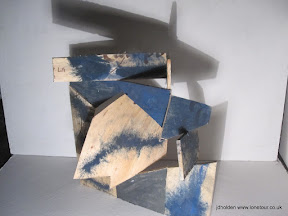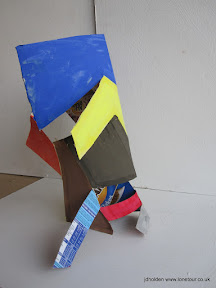Alternatively, over 200 photos of the various experiments can be seen here:
https://picasaweb.google.com/Lonetour/AbstractHeadsExperiementsApril2011#
I have a bit of a problem with the second Studio Task. The problem is, I've done it already. I've taken an Abstract Head FORM [1], and created a plaster [2] or wood model of it. Then I've FRACTURED it, either by moving the elements of plaster into new positions [3], or creating three dimensional sculptures with the wooden elements [4], or creating a mobile from a few chosen elements. Finally I've FRAMED this by taking a photo [5] (let's face it , the wood sculptures are too fragile to exist in reality for long; but one day I'll make them out of bronze and then paint them pastel colours, like Jose Pedro Croft did) or making a video [6]. Even though video isn't art. I'm not sure, but I don't think creativity and non-linear thinking are my problems with being an artist.
 [1]
[1] [2]
[2] [3]
[3] [4]
[4] [5][6]
[5][6]But I'm glad that I have completed this task already. It means I have to start again, but from where I am. I can't go back. And in any case, I don't want to seem to literal in my use of the words Form Frame Fracture.
So I sat in a café and thought. And thought. And I started playing with the words Form Frame Fracture. And ate a sandwich. And a cake. And obviously had a pot of tea. There were some interesting definitions that I liked... FORM "to make", "fashion", "to mould", "good form", and in music the form can be unique... you could move bars of music round...but why? what's the question? Why would you do that??? My tax FORM says I am a sculptor... And then I realised I should play with the words themselves and so I started making anagrams......
MORF FEAR M FREAM MAFRE RUT R FACE TRUE CARF FARC FUR CARTE RARE FUCT RAT CRUFE FUR CRATE FUR CRATE FUR CRATE FROM EFARM FUR CRATE OF REM FARM
FUR CRATE OF REM FARM
I like the idea of having rules and breaking them; so even though my rule was that each anagram should be contained within the original word, I ended up with "Fur crate of REM farm". I conceived a piece where I would make a crate from old pieces of wood, cover this in fur, make a silver foil helmet connected to a bank of computer monitors to "capture" my dreams, and finally do a performance piece using my old karate and contemporary dance skills to interpret being placed in the crate and having my dreams farmed.
And then I remembered that I am not a conceptual artist. This is arty-wank at its worst. I might be able to play the game, but for me, it's just not art. I like things. I like to make things. Martin Creed might be right when he says there are enough things in the world, but there will never be enough beautiful things that speak intimately and individually to people. And so, to start again...
But where to start? Well, with an Abstract Head FORM. And some cardboard. First to create a 2D plane with all the parts. [7] Then to create a single form, using masking tape. [8] Then to morph the form into a cylinder.[9] Of course it´s not a complete cylinder, as the cardboard won´t bend perfectly. And then to FRACTURE it by cutting some adjoining planes, allowing the cardboard to try to reform a flat surface.[10,11,12] This works pretty well, and I could imagine it created as a 10m high Cor-Ten steel sculpture in a roundabout, especially one approached from the top of a hill. But now I want to define the planes again, so I paint them all a different colour.[13,14] Perhaps it´s just my colour choice, but this is looking terrible. Also, one of the sculptures loses integrity and collapses with the wet paint. I think spray paint would be better. A single colour. That seems to be working better.[15,16]
 [7]
[7] [8]
[8] [9]
[9] [10]
[10] [11]
[11] [12]
[12] [13]
[13] [14]
[14] [15]
[15] [16]
[16]Where next? How do I FRAME these sculptures? Literally, with a pictures frame? No; I like the noun. Frame: a rigid structure formed of relatively slender pieces. But I have used up all the cardboard! I have some pieces of rebar framework. I can use these somehow. To create a "missing pieces" Abstract Head. Using the frame to hold the individual pieces together. Or I have some pieces of wire taken from a cable. They are all a bit curly. But serendipity is fine in my work, which, though you might think it's very linear, is just as happy to be wavy. Then Miguel tells me it's the wrong type of metal to weld or solder. But I've got it into my head that I can create the Frame of an abstract head with all the lines being 40cm. It's just that the short lines in the single plane have to push back into the third dimension in order to appear to be short, even though they are 40cm too. I made some notes on this:

For this part of the experiment I started by making a cube [17]. I liked the look of this, the wavy lines giving it a less formal and austere quality. I started adding a few lines, obviously the horizontal and vertical lines are quite simple but then shorter lines are already being problematic.[18] Without being able to solder the wires, it's impossible to hold them in the correct place, and so the whole frame starts to slant [19]. And I realised that the form really needed to lose the supporting structure of the "back and sides" of the initial cube [20].
 [17]
[17] [18]
[18] [19]
[19] [20]
[20]These photos [21,22,23] show the concept of this piece very well. In [22] I had started to use fishing line to hold up the structure. All of the pieces of metal are the same length; but the direct frontal perspective shows the different lengths of the original form. It is only when the viewer moves that the reality of the technique can been clearly seen [23]. Of course that's not the way the sculpture will be seen in real life. When a viewer first encounters the work, it will make no "sense" until the "optimum" viewing position is found directly in front and in the middle of the appropriate side.
 [21]
[21] [22]
[22] [23]
[23]In the end I ran out of time (and patience) to complete the sculpture with all the lines of the original sketch. However, I am delighted with the result aesthetically [25] and certainly feel that with the right materials this is a style of work that needs to be explored further. The bottom right corner (detailed [26]) is particularly pleasing, given that every piece of wire is the same length.
 [25]
[25] [26]
[26]